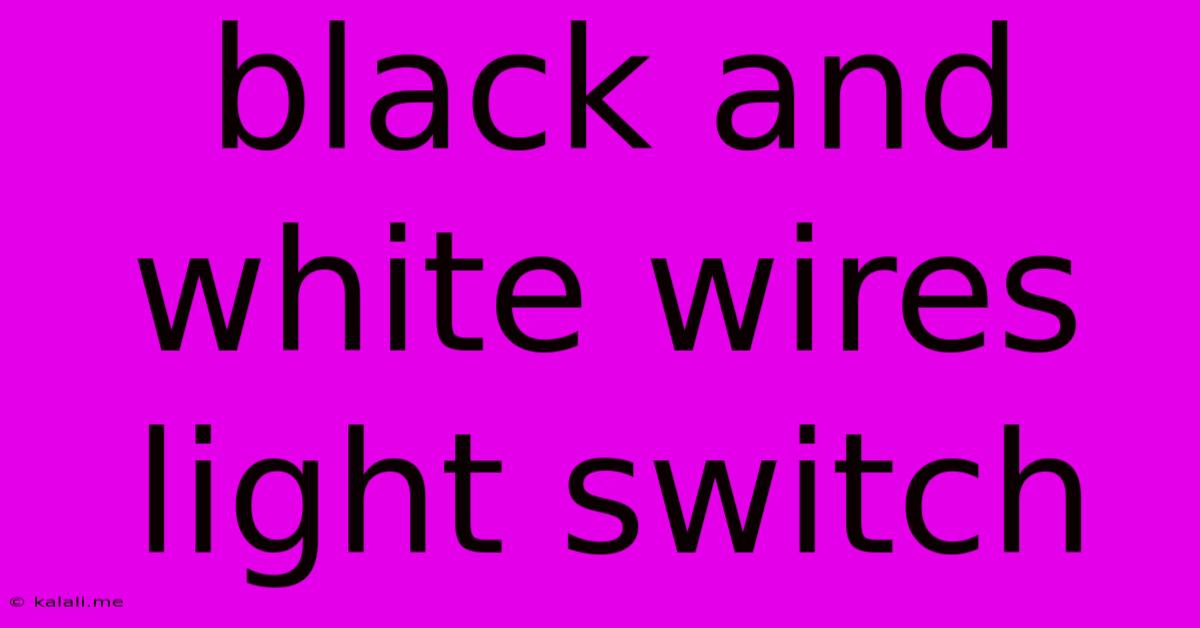Black And White Wires Light Switch
Kalali
May 25, 2025 · 3 min read

Table of Contents
Understanding Your Black and White Wires: A Simple Guide to Light Switch Wiring
So, you're staring at a light switch, and you see black and white wires. Maybe you're installing a new switch, replacing an old one, or just curious about the wiring. This guide will help you understand the function of these common wires and safely navigate the process. Knowing the difference between black and white wires in a light switch is crucial for any home improvement project.
What Do Black and White Wires Mean?
In most standard household wiring, black wires carry the "hot" power from the electrical panel to your light switch and then to your light fixture. Think of this as the energized wire that actually powers your light. White wires are the "neutral" wires, completing the electrical circuit and returning the power back to the panel. They are not energized. Understanding this fundamental difference is crucial for safe electrical work.
Common Scenarios and Wiring Configurations:
There are a few common scenarios you might encounter when working with black and white wires in a light switch:
Single-Pole Switch:
This is the most common type of light switch. It controls a light fixture from one location. The wiring is straightforward:
- Black wire (hot): Connects from the power source to the switch.
- White wire (neutral): Connects directly from the power source to the light fixture, bypassing the switch. It often has a wire nut securing multiple white wires together.
- Black wire (load): Connects from the switch to the light fixture.
Important Note: Always ensure power is OFF at the breaker before working with any electrical wiring.
Three-Way Switch:
These switches allow you to control a light fixture from two different locations. The wiring is more complex:
- Black and Red wires (traveler): These wires connect between the two three-way switches, carrying the signal between them.
- Black wire (hot/power): Connects to one of the three-way switches from the power source.
- White wire (neutral): Connects directly from the power source to the light fixture, as in a single-pole switch.
- Black wire (load): Connects from the second three-way switch to the light fixture.
The configuration of the traveler wires in a three-way switch requires careful attention to detail and correct wiring. Incorrect connections can lead to malfunction or even electrical hazards.
Troubleshooting Common Issues:
- Light doesn't work: Check the breaker to ensure power is on. Then, verify all wire connections are secure and correct.
- Flickering light: Loose connections or damaged wiring are common causes. Inspect all wire nuts and connections carefully.
- Switch feels warm: This could indicate a problem with the switch itself, loose wiring, or even a faulty breaker. Consult a qualified electrician.
Safety Precautions:
- Always turn off the power at the breaker before working with any electrical wiring.
- Use appropriate safety equipment, including insulated screwdrivers and voltage testers.
- If you're unsure about any aspect of electrical wiring, consult a qualified electrician. Electrical work can be dangerous if not done correctly.
This guide provides a basic overview of black and white wires in light switches. Remember, proper wiring is essential for both safety and functionality. If you lack experience with electrical work, seeking professional help is always the safest approach. Always prioritize safety when dealing with electrical systems.
Latest Posts
Latest Posts
-
Convert Quick Release To Through Axle
May 25, 2025
-
Punishments For The 7 Deadly Sins
May 25, 2025
-
Wire Size 200 Amp Sub Panel
May 25, 2025
-
Unexpected Eof While Looking For Matching
May 25, 2025
-
And Lead Us Not Into Temptation
May 25, 2025
Related Post
Thank you for visiting our website which covers about Black And White Wires Light Switch . We hope the information provided has been useful to you. Feel free to contact us if you have any questions or need further assistance. See you next time and don't miss to bookmark.